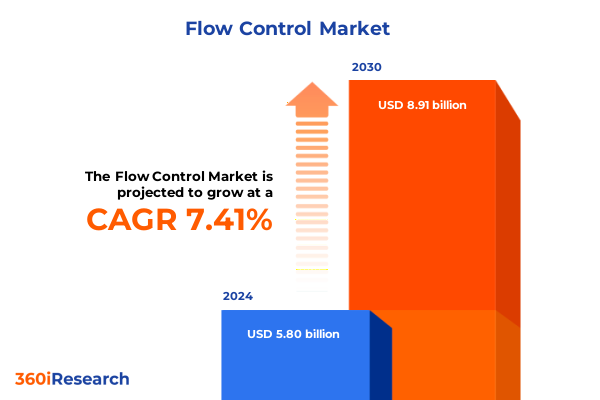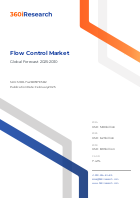The Flow Control Market size was estimated at USD 5.80 billion in 2024 and expected to reach USD 6.21 billion in 2025, at a CAGR 7.41% to reach USD 8.91 billion by 2030.

Pioneering Insights into Flow Control Dynamics
The growing complexity of industrial processes and the rapid advancement of digital technologies have converged to elevate flow control into a strategic priority for manufacturers, utilities, and process industries worldwide. As end users demand greater precision, safety, and sustainability, market participants are under mounting pressure to innovate across hardware, software, and service offerings. Global trade dynamics, supply chain vulnerabilities, and emerging regulatory frameworks further underscore the need for a holistic understanding of trends, risks, and opportunities.
This executive summary synthesizes critical findings from a rigorous investigation into current market forces, transformative shifts, and regional nuances. It provides decision-makers with the insights required to navigate tariff impacts, refine segmentation strategies, and benchmark against leading competitors. By exploring detailed market segmentation across components, network architectures, materials, connectivity, control types, applications, and end-use verticals, this report equips stakeholders with the contextual intelligence needed to seize growth pathways and mitigate potential disruptions.
Revolutionary Shifts Redefining Flow Control Technology
Industrial transformation is driving an unprecedented redefinition of flow control. The integration of smart actuators and control systems with analytics platforms has moved the discipline from reactive maintenance toward predictive optimization. Artificial intelligence algorithms now interpret sensor data in real time to adjust valve positions, detect anomalies, and forecast performance degradation.
Simultaneously, sustainability imperatives are reshaping materials and design practices. The shift toward plastics such as polypropylene and polyvinyl chloride for corrosion resistance complements traditional steel, reducing weight and energy consumption. Connectivity paradigms are also evolving, with wired architectures like Ethernet and Fieldbus coexisting with wireless protocols such as Bluetooth, Wi-Fi, and Zigbee to deliver flexible deployment models.
This confluence of digital innovation, ecological responsibility, and network diversity is accelerating the modernization of flow control portfolios. Manufacturers and end users must adapt to these transformative shifts to enhance reliability, achieve regulatory compliance, and unlock new revenue streams through service offerings and data-driven applications.
Assessing the Full Spectrum of 2025 U.S. Tariff Implications
The implementation of new tariffs in 2025 has introduced significant cost variances for hardware components imported into the United States. Actuators, valves, fittings, and flow meters sourced from major offshore suppliers now carry increased duties, prompting organizations to reassess sourcing strategies. As cost pressures mount, some original equipment manufacturers are realigning production closer to end-use markets to maintain price competitiveness.
In response, a subset of suppliers is exploring tariff engineering to minimize duty liabilities, leveraging material substitutions and product reclassification where permissible. Software and digital offerings, which face lower tariff barriers, have gained emphasis in corporate roadmaps, offsetting hardware margin compression. However, this shift accentuates the importance of robust supply chain resilience as firms diversify procurement channels across multiple regions.
Despite short-term headwinds, the tariff environment is driving long-term benefits by accelerating localization trends and fostering innovation in domestic manufacturing. Stakeholders that proactively model tariff scenarios and integrate them into strategic planning will be best positioned to safeguard margins and sustain growth amid evolving trade dynamics.
Decoding the Market through Comprehensive Segmentation
A nuanced understanding of market segmentation reveals the pathways for targeted growth and product development. Examining product architecture, hardware offerings encompass actuators-whether electric, hydraulic, manual, or pneumatic-paired with sophisticated control systems, valves ranging from ball to globe, and precision flow meters and fittings, while software solutions drive real-time monitoring and optimization.
Network segmentation distinguishes between closed loop feedback systems and open loop configurations, each serving distinct performance and cost profiles. Material considerations balance the robustness of steel against the corrosion resistance and lightweight properties of polypropylene and PVC. Connectivity choices span wired frameworks such as Ethernet and Fieldbus alongside wireless protocols like Bluetooth, Wi-Fi, and Zigbee to satisfy diverse installation scenarios.
Control types include sliding window, stop, and wait flow methodologies, enabling precise throughput management across process industries. Application segmentation differentiates automatic and hand-operated control valves, level regulation, pressure modulation, and temperature control systems. Finally, end-use segmentation guides investment by highlighting heavy industries such as chemicals, energy and power, and mining, as well as downstream, midstream, and upstream oil and gas, pharmaceutical and biotechnology, residential, and municipal and industrial water and wastewater treatment.
This comprehensive research report categorizes the Flow Control market into clearly defined segments, providing a detailed analysis of emerging trends and precise revenue forecasts to support strategic decision-making.
- Components
- Network Type
- Material Type
- Connectivity
- Type
- Application
- End-Use
Regional Perspectives Shaping Global Flow Control Trends
Regional dynamics play a critical role in shaping investment priorities and competitive landscapes. In the Americas, mature manufacturing hubs and an established infrastructure for energy and power drive steady demand for precision control systems, while emerging opportunities in residential water treatment signal incremental growth in urban markets.
Europe, the Middle East, and Africa present a tapestry of regulatory environments and industrial profiles. Western Europe’s stringent environmental standards catalyze adoption of high-performance, low-emission control solutions. In contrast, Middle Eastern markets focus on large-scale oil and gas investments, and North African industrialization initiatives support rising uptake of modular control architectures.
Asia-Pacific remains the fastest growing region, fueled by rapid industrialization in China and India, expanding chemical and pharmaceutical sectors, and a surge in municipal water infrastructure projects. The region’s emphasis on smart city initiatives and renewable energy integration underscores the strategic importance of scalable, interoperable flow control systems tailored to diverse climatic and regulatory conditions.
This comprehensive research report examines key regions that drive the evolution of the Flow Control market, offering deep insights into regional trends, growth factors, and industry developments that are influencing market performance.
- Americas
- Europe, Middle East & Africa
- Asia-Pacific
Strategic Company Profiles Driving Market Innovation
Leading companies are forging competitive advantages through innovation, strategic partnerships, and vertical integration. Industry stalwarts are investing heavily in research to enhance actuator responsiveness and valve sealing technologies, while digital natives are specializing in advanced analytics platforms that transform raw data into actionable control insights.
Collaborative alliances between hardware manufacturers and software developers are proliferating, resulting in end-to-end solutions that span from sensor to cloud. Several market leaders have announced acquisitions to fortify their portfolios, merging complementary technologies to capture expanded market share in key verticals. Simultaneously, start-ups are introducing niche offerings, such as AI-enabled valve diagnostics and energy-efficient pneumatic actuators, challenging incumbents to accelerate their innovation cycles.
Capitalizing on these dynamics requires a keen focus on ecosystem orchestration, balancing in-house R&D with strategic licensing or co-development agreements. Stakeholders that align their product roadmaps with emerging digital service models and sustainability goals will emerge as front-runners in the increasingly competitive flow control arena.
This comprehensive research report delivers an in-depth overview of the principal market players in the Flow Control market, evaluating their market share, strategic initiatives, and competitive positioning to illuminate the factors shaping the competitive landscape.
- ABB Ltd.
- Alfa Laval AB
- Azbil Corporation
- Badger Meter, Inc.
- Circor International, Inc.
- Crane Holdings, Co.
- Emerson Electric Co.
- Endress+Hauser AG
- Flowserve Corporation
- Fluidra S.A.
- Fratelli Tognella S.p.A
- General Electric Company
- Hitachi High-Tech Corporation
- Honeywell International Inc.
- IMI Critical Engineering
- Katronic Technologies Ltd.
- KEM Küppers Elektromechanik GmbH
- KITZ Corporation
- Max Machinery, Inc.
- Parker Hannifin Corporation
- Robert Bosch GmbH
- Rotork PLC
- Samson Controls Inc.
- Schlumberger NV
- Schneider Electric SE
- Sick AG
- Valmet Oyj
- Weatherford International PLC
- Yokogawa Electric Corporation
Practical Recommendations to Accelerate Competitive Advantage
Successful industry participants should pursue diversified sourcing to mitigate tariff exposure and ensure supply continuity. Integrating regional manufacturing nodes with agile logistics frameworks will balance cost efficiency against responsiveness to end-user demands. Concurrently, investments in digital twin technologies and cloud-based control platforms will deliver predictive maintenance capabilities, reducing downtime and total cost of ownership.
Product differentiation should leverage material innovations-such as advanced polymers for corrosive environments-and modular connectivity architectures that support seamless integration across wired and wireless networks. Embedding artificial intelligence at the actuator and valve level will unlock new service revenues, enabling performance-based contracts and subscription models.
Finally, forging collaborative ecosystems with software providers, system integrators, and end users will accelerate time to market for novel solutions. By aligning R&D roadmaps with sustainability mandates and customer pain points, industry leaders can secure premium positioning and cultivate long-term partnerships across diverse end-use sectors.
Transparent Research Framework Underpinning Our Findings
Our findings rest on a multi-stage research approach combining primary and secondary data sources. In-depth interviews with industry executives and technical specialists provided first-hand perspectives on emerging trends, tariff impacts, and innovation trajectories. Secondary research encompassed analysis of regulatory publications, trade data, and technical white papers to validate and contextualize interview insights.
Data triangulation techniques ensured the reliability of segmentation frameworks, tariff assessments, and regional analyses. Quantitative modeling captured the interplay between cost drivers and adoption rates, while qualitative assessments elucidated strategic intents behind key partnerships and M&A activity. Rigorous data cleaning and peer reviews guaranteed methodological transparency and reproducibility of results.
This robust research framework underpins the comprehensive recommendations and insights presented throughout this executive summary, offering stakeholders a dependable foundation for strategic decision-making and investment prioritization.
Explore AI-driven insights for the Flow Control market with ResearchAI on our online platform, providing deeper, data-backed market analysis.
Ask ResearchAI anything
World's First Innovative Al for Market Research
Synthesizing Key Takeaways for Informed Decision-Making
Integrating macroeconomic pressures, technology evolution, and trade developments reveals a dynamic flow control market characterized by both disruption and opportunity. The 2025 tariff environment is reshaping supply chains and accelerating localization, while digital and sustainability imperatives demand continuous innovation in materials, connectivity, and control strategies.
Segmentation analysis underscores the importance of tailored offerings across components, network types, and end-use verticals, guiding resource allocation toward the highest-value market niches. Regional insights illustrate diverse growth trajectories, from mature demand in the Americas to rapid expansion in Asia-Pacific and varied regulatory landscapes across Europe, the Middle East, and Africa.
Leading firms are responding with strategic investments in R&D, ecosystem collaborations, and predictive service models. By acting on the actionable recommendations supplied herein and leveraging rigorous research methodologies, stakeholders can navigate volatility, optimize portfolio performance, and capture emerging revenue streams in an increasingly competitive global market.
This section provides a structured overview of the report, outlining key chapters and topics covered for easy reference in our Flow Control market comprehensive research report.
- Preface
- Research Methodology
- Executive Summary
- Market Overview
- Market Dynamics
- Market Insights
- Cumulative Impact of United States Tariffs 2025
- Flow Control Market, by Components
- Flow Control Market, by Network Type
- Flow Control Market, by Material Type
- Flow Control Market, by Connectivity
- Flow Control Market, by Type
- Flow Control Market, by Application
- Flow Control Market, by End-Use
- Americas Flow Control Market
- Europe, Middle East & Africa Flow Control Market
- Asia-Pacific Flow Control Market
- Competitive Landscape
- ResearchAI
- ResearchStatistics
- ResearchContacts
- ResearchArticles
- Appendix
- List of Figures [Total: 30]
- List of Tables [Total: 775 ]
Secure Your Expert Analysis with Our Detailed Market Report
Elevate your strategic planning and gain an authoritative edge in the flow control market by accessing our in-depth research report. Reach out directly to Ketan Rohom (Associate Director, Sales & Marketing) to explore tailored insights and licensing options that align with your organizational objectives. Secure comprehensive analyses, actionable data, and expert validation to drive confident decision-making and maximize growth opportunities.

- How big is the Flow Control Market?
- What is the Flow Control Market growth?
- When do I get the report?
- In what format does this report get delivered to me?
- How long has 360iResearch been around?
- What if I have a question about your reports?
- Can I share this report with my team?
- Can I use your research in my presentation?




